 |
Distinguished Service Cross |
Personnel
Mission Reports
DISTINGUISHED SERVICE CROSS RECIPIENTS
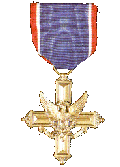
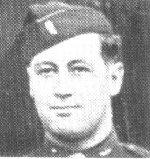 "For gallantry in action . . . while serving as bombardier . . . on 26 November 1943. A 20mm. shell exploded in the nose, killed the navigator, seriously injured Lt. Spencer, and destroyed the plexiglass nose. The flight engineer removed Lt. Spencer to a position of safety, but Lt. Spencer, realizing that enemy fighters were attacking and thinking only of protecting his crew members and the plane, crawled back to his guns to ward off the attacks. Exposing himself to the extreme cold blast through the nose, and facing the possibility of being thrown out by evasive action, Lt. Spencer remained at his post until the attacks ceased. In doing so, Lt. Spencer sustained frostbite so severe that only by the barest margin were surgeons able to save his life . . ."
"For gallantry in action . . . while serving as bombardier . . . on 26 November 1943. A 20mm. shell exploded in the nose, killed the navigator, seriously injured Lt. Spencer, and destroyed the plexiglass nose. The flight engineer removed Lt. Spencer to a position of safety, but Lt. Spencer, realizing that enemy fighters were attacking and thinking only of protecting his crew members and the plane, crawled back to his guns to ward off the attacks. Exposing himself to the extreme cold blast through the nose, and facing the possibility of being thrown out by evasive action, Lt. Spencer remained at his post until the attacks ceased. In doing so, Lt. Spencer sustained frostbite so severe that only by the barest margin were surgeons able to save his life . . ."The 26th of November 1943 saw the largest 8AF operation to date. That day 35 303rd B-17s were part of an 8th Air Force formation of over 500 bombers sent to Bremen in northern Germany. As the 303rd formation began its bomb run, the B-17 Stardust, of the 358th Bomb Squadron, was seriously damaged by three German fighters attacking from the nose. 20mm shells knocked out the nose plexiglas, instantly killing the navigator and seriously wounding Spencer, the bombardier. Lt Spencer suffered serious cuts on his face and had his helmet and oxygen mask ripped off, and with the air temperature minus 67 degrees, he lay in the wind swept nose until the flight engineer dragged him into the pilot's compartment. By this time his face was so swollen it was hard to see his nose and it was difficult to give him oxygen. The flight engineer then left to attend to other wounded crew members. Lt Spencer, barely conscious and frozen, heard the enemy fighters attacking and struggled back to his nose guns, exposing himself to the blast of extremely cold air coming through the shattered nose, and the risk of being thrown out by the violent maneuvers of the aircraft. He continued to fire his guns until the enemy attacks ceased, and was found unconscious under his guns when the badly mangled B-17 and crew managed to make an emergency landing at Docking-Fort, England. Although thought dead, Lt Spencer survived despite loss of all of his fingers, an eye, and months of operations to rebuild his face and a new nose and ears. Lt Spencer spent 2 1/2 years in the hospital. He was awarded the nation's second highest award for heroism, the Distinguished Service Cross. After graduating from a Seminary, he was Chaplain of the Kansas Soldiers Home for 29 years. Now completely blind, he lives in Dodge City with his wife of 56 years.

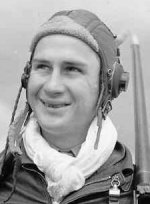 "For extraordinary heroism . . . while serving as tail gunner on a mission to Germany on 22 February 1944. Before reaching the target Sgt. Werner was seriously wounded by a 20mm. shell. He realized that with most attacks being made from the tail the ship would be doomed unless a steady stream of fire was maintained from the tail gun. In spite of his painful wounds he stayed at his post and destroyed at least one enemy fighter. Although wounded again by anti-aircraft fire and becoming weaker from loss of blood, he heroically stayed at his guns until all fighter attacks ceased before letting crew mates give him first aid."
"For extraordinary heroism . . . while serving as tail gunner on a mission to Germany on 22 February 1944. Before reaching the target Sgt. Werner was seriously wounded by a 20mm. shell. He realized that with most attacks being made from the tail the ship would be doomed unless a steady stream of fire was maintained from the tail gun. In spite of his painful wounds he stayed at his post and destroyed at least one enemy fighter. Although wounded again by anti-aircraft fire and becoming weaker from loss of blood, he heroically stayed at his guns until all fighter attacks ceased before letting crew mates give him first aid."On the 22nd of February 1944, the 303rd was part of the 8AF formation which struck the Junkers aircraft plant at Aschersleben. The tail gunner aboard the B-17 Luscious Lady of the 427th Bomb Squadron was SSgt William T.L. Werner, from Lebanon, Pennsylvania. About an hour and a half before reaching the target, during heavy German fighter attacks, a 20mm shell seriously injured Sgt Werner. Realizing that survival of the B-17 depended upon him being able to defend it from rear attacks, he remained at his post and continued firing his guns without pause. About 20 or 30 minutes later the aircraft was hit by flak and Sgt Werner received wounds in the arms, abdominal area, and leg. Only after all fighter attacks ceased did Sgt Werner, weakened by loss of blood, crawl to the waist gunners compartment and collapse. He had survived because flak had knocked out his heated flight suit and the freezing temperatures lowered his body temperature and helped the blood from his wounds coagulate quickly. Sgt Werner was awarded the Distinguished Service Cross for his actions.

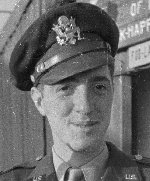 "For extraordinary heroism . . . while serving as bombardier on a mission to Germany, 13 April 1944. Before the plane reached the target it was viciously attacked by enemy fighters, and Lt. Dello Buono was seriously injured by a 20mm shell which exploded on contact with his flak suit. Despite the seriousness of his wounds, Lt. Dello Buono manned his nose guns until the target was reached, and then dropped his bombs squarely in the group's pattern. He then returned to his guns and, ignoring his pain and the danger of frostbite from the cold air blasting through the nose, refused to leave his post until fighter attacks had ceased and the enemy coast had been passed on the way home."
"For extraordinary heroism . . . while serving as bombardier on a mission to Germany, 13 April 1944. Before the plane reached the target it was viciously attacked by enemy fighters, and Lt. Dello Buono was seriously injured by a 20mm shell which exploded on contact with his flak suit. Despite the seriousness of his wounds, Lt. Dello Buono manned his nose guns until the target was reached, and then dropped his bombs squarely in the group's pattern. He then returned to his guns and, ignoring his pain and the danger of frostbite from the cold air blasting through the nose, refused to leave his post until fighter attacks had ceased and the enemy coast had been passed on the way home."On the 13th of April, 1944, the 303rd Bomb Group was on another OAF mission against the ballbearing plants of Schweinfurt, Germany. 2Lt Thomas J. Dello Buono, a native of New York City, was the bombardier aboard the B-17 Idaliza of the 360th Bomb Squadron. During attacks by a swarm of German fighters, a 20mm shell shattered the plexiglas in the nose of Idaliza and exploded on the flak vest of Lt Dello Buono, seriously wounding him. One half-inch piece of shrapnel lodged in his chest near his heart. His left thumb was severed at the first joint and fragments of the shattered plexiglas lodged in his right shoulder. Knocked 12 feet to the back of the compartment, after regaining consciousness he crawled back to his nose gun, refused morphine and continued to fire at the enemy aircraft with the frigid winds blowing through the shattered nose compartment. Forty minutes later, when the formation reached the target, he dropped his bombs squarely on the target. Refusing his crewmates request to move back to the comparative warmth of the radio room, he then continued to man his guns against the enemy fighters. Only when they crossed the enemy coast, and England was in sight, did he agree to move out of the forward compartment, suffering from a painful case of frostbite. Lt Dello Buono was awarded the nation's second highest award for heroism, the Distinguished Service Cross, the third 303rd airman to be so honored.

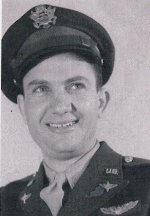 "For extraordinary heroism in connection with military operations against an armed enemy of the United States while serving as B-17 pilot from the period 17 November 1942, to 15 June 1944 . . . On all occasions he has demonstrated exemplary and courageous leadership, employing skilful and effective counter measures against whatever fighter opposition he has encountered and bombing enemy installations with consistently excellent results . . . Colonel Lyle's heroic and fearless leadership and his continued determination to fulfil his assigned task in the face of all odds has reflected highest credit upon himself and the Armed Forces of the United States."
"For extraordinary heroism in connection with military operations against an armed enemy of the United States while serving as B-17 pilot from the period 17 November 1942, to 15 June 1944 . . . On all occasions he has demonstrated exemplary and courageous leadership, employing skilful and effective counter measures against whatever fighter opposition he has encountered and bombing enemy installations with consistently excellent results . . . Colonel Lyle's heroic and fearless leadership and his continued determination to fulfil his assigned task in the face of all odds has reflected highest credit upon himself and the Armed Forces of the United States."This was the first DSC ever awarded in the ETO for consistent, outstanding heroism and an overall superior job. Col. Lyle was one of the 303rd BG(H)'s original pilots. At the time of his award, he had flown 51 missions with the 303rd BG(H). In addition, he flew two bombing missions in North Africa during the campaign there. He was the first 8th Air Force pilot to complete 30 missions and immediately volunteered for another tour. He flew on many of the Group's most dangerous missions. On all of his missions, Col. Lyle emphasized bombing accuracy over all other flying elements. For weeks he carefully studied and trained as a bombardier and flew three missions as a bombardier, doing an excellent job on two of them. On another occasion he flew as a bombing observer. An appraisal of the bombing results on missions that he led indicated an unusually high percentage of bombs hitting near the aiming point. He was a leader on most of his missions, including commanding a Squadron 12 times, the Group 19 times, the Combat Wing 11 times, and the Air Division three times.